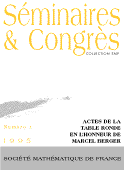 Séminaires et Congrès - 5 - pages 119-131 | |
|

| |  |
Arithmétique des revêtements algébriques - Actes du colloque de Saint-Étienne
Bruno Deschamps (Éd.)
Séminaires et Congrès 5 (2001), xx+214 pages
Descente, champs et gerbes de Hurwitz
Jean-Claude Douai
Séminaires et Congrès 5 (2001), 119-131
Download :
PS file
/
PDF file
Résumé :
Nous montrons comment les notions de gerbe et de champ introduites par A. Grothendieck interviennent naturellement dans la théorie des revêtements. À un G-revêtement ![]() de corps des modules K est associée une K-gerbe
de corps des modules K est associée une K-gerbe ![]() liée par le centre Z(G) de G qui est, en fait, la gerbe résiduelle en le point
liée par le centre Z(G) de G qui est, en fait, la gerbe résiduelle en le point ![]() d'un champ algébrique plus général défini sur
d'un champ algébrique plus général défini sur ![]() . Nous montrons ensuite comment l'utilisation des approximations diophantiennes dans les gerbes et les champs conduit à des résultats du type Principe de Hasse.
. Nous montrons ensuite comment l'utilisation des approximations diophantiennes dans les gerbes et les champs conduit à des résultats du type Principe de Hasse.
Mots clefs : Champs, gerbes, revêtement, descente, modules grossiers, modules fins
Abstract:
Descent, Stacks and Hurwitz Gerbs
We show that the notions of gerb and stack intoduced by Grothendieck occur naturally in the theory of coverings. To a G-covering ![]() of the field of moduli K is associated a K-gerb
of the field of moduli K is associated a K-gerb ![]() bound by the center Z(G) of G. This gerb is, in fact, the residual gerb in the point
bound by the center Z(G) of G. This gerb is, in fact, the residual gerb in the point ![]() of a more general algebraic stack defined over
of a more general algebraic stack defined over ![]() . We can use the diophantine approximations in the gerbs and stacks to get result of the type Hasse Principle.
. We can use the diophantine approximations in the gerbs and stacks to get result of the type Hasse Principle.
Key words: Stacks, Gerbs, Covering, Descent, Coarse Moduli, Fine Moduli
Class. math. : 18G50, 14E20, 14Dxx, 14D22